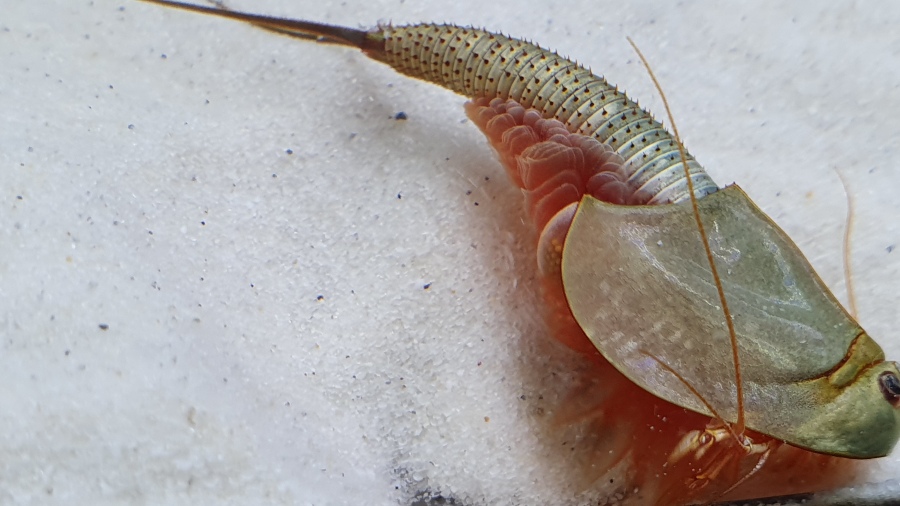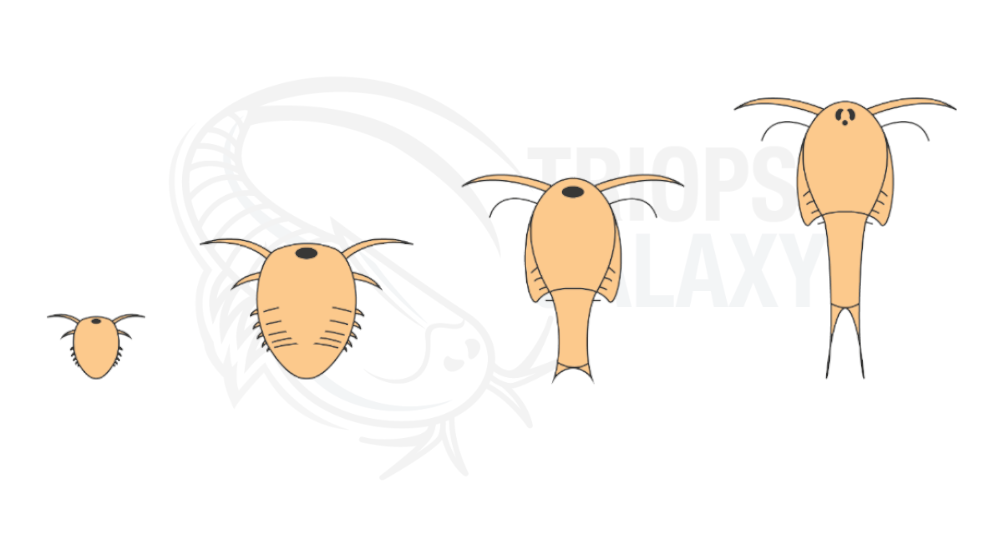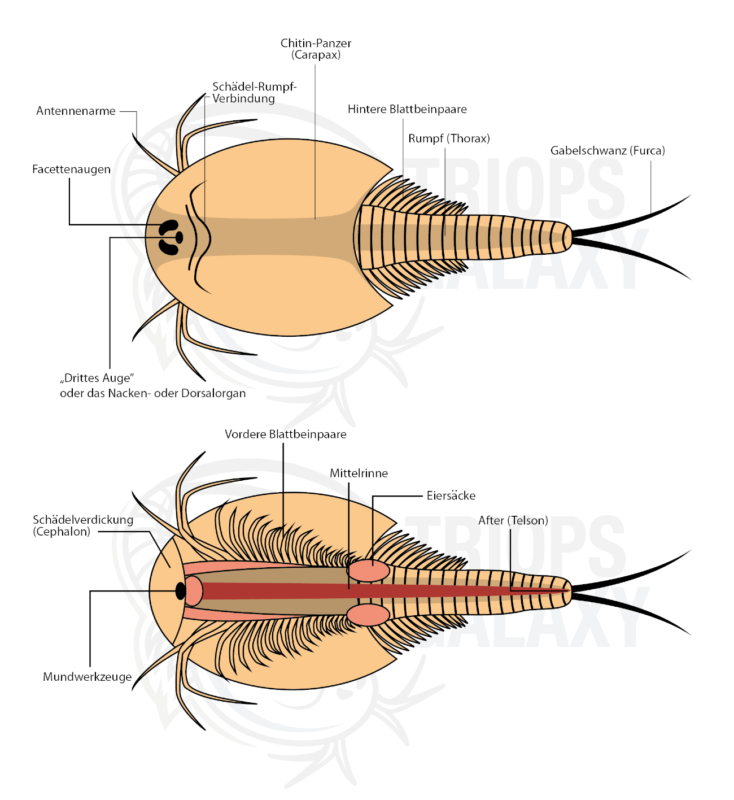Guide
Triops Anatomy: Morphology of the prehistoric crustaceans
It used to be assumed that the Triops anatomy has remained unchanged for several million years, but recent scientific research has shown that the animals have evolved genetically. Nevertheless, purely in terms of appearance, not much has changed and they look exactly like their ancestors who already lived on earth during the times of the dinosaurs. At the time the prehistoric crustaceans evolved, organs such as the brain and heart were still very underdeveloped, so you could say that the Triops’ anatomy is very primitive. But it is precisely this primitiveness that has allowed the Triops to survive for over 200 million years and will possibly allow them to survive for millions more. One day, when humanity has left its home planet and found a new home on an exoplanet, Triops will live on Earth as they did in Mesozoic times. In this section, we look at the nauplius stages as well as Triops anatomy.

Triops Anatomy: Nauplii Stages
Under optimal breeding conditions, hatching can begin after only 13 hours. As a rule, the nauplii hatch within 24 hours, but it can sometimes take up to two weeks. The Triops undergo an incredible metamorphosis in the first few days of life, during which nauplii with a size of just one millimetre hatch from tiny eggs the size of a grain of sand. The first few days are sometimes the most critical during the entire breeding process and not all nauplii survive. Those that do make it develop from tiny nauplii to adults within a few days. Below we go through all four developmental stages of the Triops.
Triops Anatomy: First Nauplii Stage
Immediately after hatching, after they have freed themselves from the cyst shell, the nauplii are still very weak and move very tentatively and twitching in the tank. They rise a few centimetres and then drop back to the bottom. They do not yet have the strength to move continuously in the water. The water current determines the swimming direction. They have a teardrop-shaped body, less than a millimetre in size with the colours and caramel. It is very difficult, especially for beginners without a trained eye, to recognise the tiny nauplii in the water. You have to look very closely. Characteristic are the extremities on the body, which are covered with fine bristles in order to filter tiny organisms such as paramecia and ciliates out of the water and feed on them.
These extremities, which resemble an antenna and act as swimming legs, serve the nauplii for locomotion and support of the mandibles (upper jaw, first pair of mouth limbs in arthropods). While these are used for locomotion with rhythmic beats in the first days of life, over time they develop into useful tools for grasping, chewing and biting food. At the tip of the body there is a point eye to be able to distinguish light and dark contrasts. However, this eye is not yet developed enough to fully perceive objects. The three pairs of extremities include the antennula or antennae, often called the “first antenna”, and the second antenna and mandible. The upper lip (labrum) closes the digestive tract. The nauplii do not have mouthparts at this stage, so they are unable to eat on their own and feed exclusively on the yolk sac attached to their body.
Triops Anatomy: Second Nauplii Stage
A good six to 13 hours after hatching, the first moult occurs and the second nauplius stage begins. The nauplius experiences an incredible growth spurt, during which the body length doubles and the shape increasingly resembles that of an adult Triops. This is an extremely interesting development in Triops anatomy. The extremities are now more pronounced, allowing the nauplius to move faster and with fewer pauses. Slowly, contours emerge that serve as anlagen for the spread forked tail and the telson (anal segment). This segment can be recognised by the pointed end of the trunk, which begins to split open.
Small notches can already be seen here, which contribute to the growth of new segments by means of teloblasty. Teloblastic segment formation is a developmental process in which, starting from a sprouting zone, new segments are formed from the back to the front. The pairs of legs that grow from this serve for locomotion as well as for the identification of food. The eye of the nauplius has become somewhat larger in the second stage, but has not yet matured. As the nauplius has changed colour and is now white to transparent, it is even more difficult to recognise. A dark background behind the tank creates a high contrast so that the nauplii can be easily recognised.
Third nauplius stage
Approx. 24 to 36 hours after hatching, the nauplii is in the third nauplius stage and has grown considerably in size. Since the first naupliar stage, it has increased three times its body length and measures about three millimetres. The segmental attachments reveal the leg systems or the leaf leg attachments and the forked tail grows in length so that its movements are made through the abdomen. This still has a cone shape, which is an indication of irregular anamery. This means that at this stage posterior segments of the body are in function earlier than those closer to the head. The antennal arms for orientation in the adult stage have developed and lost their bristles. They no longer serve for locomotion, as the nauplius now moves by rhythmic movements of the abdomen. Under the barely developed dorsal shield (carapace) the antennae are not yet or barely visible.
The Triops anatomy continues to develop. On the back, the anatomy of the skull plate can be seen, which at this stage covers about a quarter of the torso. The appendages are more developed and serve for orientation in the water. The nauplius turns the back shield of the light source, as it now has the light back reflex. Although the ommatidia have yet to be formed and the nauplius can only see a strongly gridded environment, two compound eyes are developed in addition to the median osmo-regulatory organ. The mandibles (mouthparts) slowly develop and the upper lip forms a cranial thickening. With this, the Triops will burrow in the sand and search for food in adulthood. Due to the formed middle groove, the nauplius has already developed a taste stimulus and can distinguish between edible and inedible food. The third stage nauplius is able to eat fine algae powder and even nibble on tiny granules.
Fourth nauplius stage
With a size of five millimetres, the nauplii reach the fourth and final naupliar stage after three to four days with all the body characteristics of an adult animal. Already now, the nauplius is very active and forages for food without pause, taking in the food via its mouthparts. The antennal arms are fully developed and fulfil the function of orientation and foraging. The skull plate is now a good half of the trunk length with the two typical pointed ends and is getting colour, regardless of the Triops species. The skull thickening, which is no longer transparent, will acquire the greyish-white colour as it progresses.
A median furrow has developed in the carapace and the adult leaf legs provide oxygen intake. At the end of the trunk, the forked tail with its thin, elongated shape is like that of an adult and is between one third and one half of the body length of the nauplius. Since the leg systems are fully grown but do not move yet, the abdomen still takes over locomotion. By moving rhythmically against the water resistance, the Triops swims smoothly. In the next few days, the leaf legs will take over the task of locomotion and the Triops anatomy will continue to develop.

Adult Triops
Five days after hatching, the small nauplii will reach the adult stage and will only change minimally in appearance from this point on. The adult Triops will continue to grow and reach many times its original size. The species Triops longicaudatus reaches a size of up to seven centimetres. The Asian species Triops granarius grows up to ten centimetres. At the age of about two weeks, Triops reaches sexual maturity and develops the reproductive organs. The egg sacs in which the eggs are produced come into view.
Eyes: compound eyes (ocellus) and third eye
Triops have two oval compound eyes located in the skull plate. These perceive light and dark contrasts, but cannot recognise colours and distances. These compound eyes, which are sessile and bound into the carapace, are equipped with about 250 ommatidia (individual eyes) and allow a gridded and blurred perception of the surroundings. The Triops cannot move its eyes, the dome shape enables all-round vision. Triops eyes are built like insect eyes, but covered with an additional shell. This functions under water like diving goggles and protects the eyes during moulting. The Triops anatomy is similar to that of insects. Comparatively, the compound eyes of insects consist of about 28,000 individual eyes.
The third eye lies centrally (median) on the forehead. Together with the two compound eyes, the three eyes are arranged in a triangle and give rise to the name of the “three-eyed” Triops (Tri = three; Ops = eye), which comes from the Greek. The third eye is often mistakenly called the “nauplius eye” or “median eye”. However, this widespread designation is completely wrong. The third Triops eye is responsible for osmosis regulation and serves the purpose of measuring the salinity of a body of water. In order to adapt to the rapidly changing salinity, the third eye is vital for the Triops as a nuchal or dorsal organ.
Mouth parts
The Triops’ mouth is located at the upper end of the midrib. Triops transport food via this reddish line on the trunk. The mouthparts are located there, with which pieces of food are processed so that they can be swallowed and digested. Several sharp plates rub against each other and the food is held by small gripping tools to process it.
Fork tail (Furca)
With a length of three to five centimetres, the forked tail fulfils the task of stabilising the swimming movements of Triops and is the last body segment on the abdomen. The furca (Latin for two-pronged fork) is not vital for Triops, as the anus is located at the end of the abdominal segment between the two forks. The anus is opened and closed by the muscle ring and two chitin plates. Even if parts of the furca are bitten off by other Triops, they grow back during the next moult. The Triops anatomy is truly amazing.
Antenna arms, antennae
The Triops uses its two antennal arms for feeling, to scan and taste the bottom surface and to sense the finest movements in the water. The antennae originate at the base of the trunk at the level of the mouthparts and divide into three parts of different lengths at the level of the skull plate. With the help of the antennal arms, whose length increases considerably with age, the Triops can orientate itself in its environment and detect food. The antennae can reach three times the size of the skull plate.
Leaf leg pairs
Other characteristic features of the Triops anatomy are the pairs of leaf legs. Triops have up to 79 pairs of legs. The front pairs of legs or pereiopods are much more strongly developed than the pairs of legs on the abdomen and are used for locomotion. In contrast to the hind legs, the front leg pairs are used to a lesser extent for respiration. The characteristic shovel shape enables Triops to dig in the sand and search for food and facilitates locomotion in the water.
The rear pairs of legs are permeated with a fine capillary system. The primary task of the wafer-thin rear pairs of legs is respiration. Like the gills of a fish, the Triops’ blood is enriched with oxygen. The hind legs extend from the indentation of the skull plate and the egg sacs to the lower part of the trunk. Towards the tail they become smaller. They also serve to stir up and pick up anything edible in the substrate.
Skull plate, dorsal carapace (carapace)
The skull plate is a flat chitinous plate, keeled in the middle, located on the top of the animal and about the size of a thumbnail, which protects the Triops from attacks from above. In order to keep resistance to swimming as low as possible, the skull plate is wedge-shaped. The carapace supports the skeleton of the Triops and is particularly advantageous when searching for food, as the animal can burrow in the ground with the help of the skull plate. The dorsal carapace can cover up to half of the body.
Connection skull plate – trunk (nervous system, brain)
Let’s continue with the Triops anatomy. Above the eyes on the skull plate is a bar-shaped thickening. This is the connecting piece between the torso and the skull plate. Under this thickening is the central nervous system of the Triops. A double strand running along the ventral side with a nerve node (ganglion) as well as one transverse connection per segment, also called the cord ladder nervous system, condenses into a node. This upper lobe ganglion is also seen as the brain of the Triops.
Thickening of the skull (cephalon)
The crescent-shaped thickening is located at the tip of the underside of the skull plate. With the help of this thickening, the Triops is able to push its head into the substrate and burrow through it.
Trunk (thorax)
The trunk extends from the base of the carapace to the anus and consists of several interlocking chitinous rings. Their number varies between eight and 17 and these protect the Triops’ organs.
Heart
In the Triops anatomy, there is also a primitive heart. It is, as in many arthropods, a long, dorsal heart without arteries. The heart pumps the Triops’ blood through an open circulatory system so that it flows freely past all organs. Thus, even the smallest injuries are fatal for the Triops, the animal suffers a haematoma.
Kidney
In the Triops anatomy there is no liver, but there is a kidney. The kidney filters toxins and is responsible for regulating the body fluid in relation to the salt content of the water.
Egg sacks
After about ten to 14 days, the Triops females reach sexual maturity. On the 11th pair of legs below the carapace, the females grow small pockets in which the eggs are formed. A gonad ensures that the female produces eggs continuously. These fall into the egg sac to mature there. After maturation, the eggs are shaken out of the sac. The female can carry up to 200 eggs in the sac and lay three times a day. The eggs are coated by a gland with a secretion that sticks to the substrate and protects the eggs from enemies.
Anus (Telson)
The anus is located between the two tips of the forked tail at the end of the trunk. Unusable food remains, detritus, are excreted. The anus consists of two chitinous plates that are opened and closed with the help of a muscle ring.
